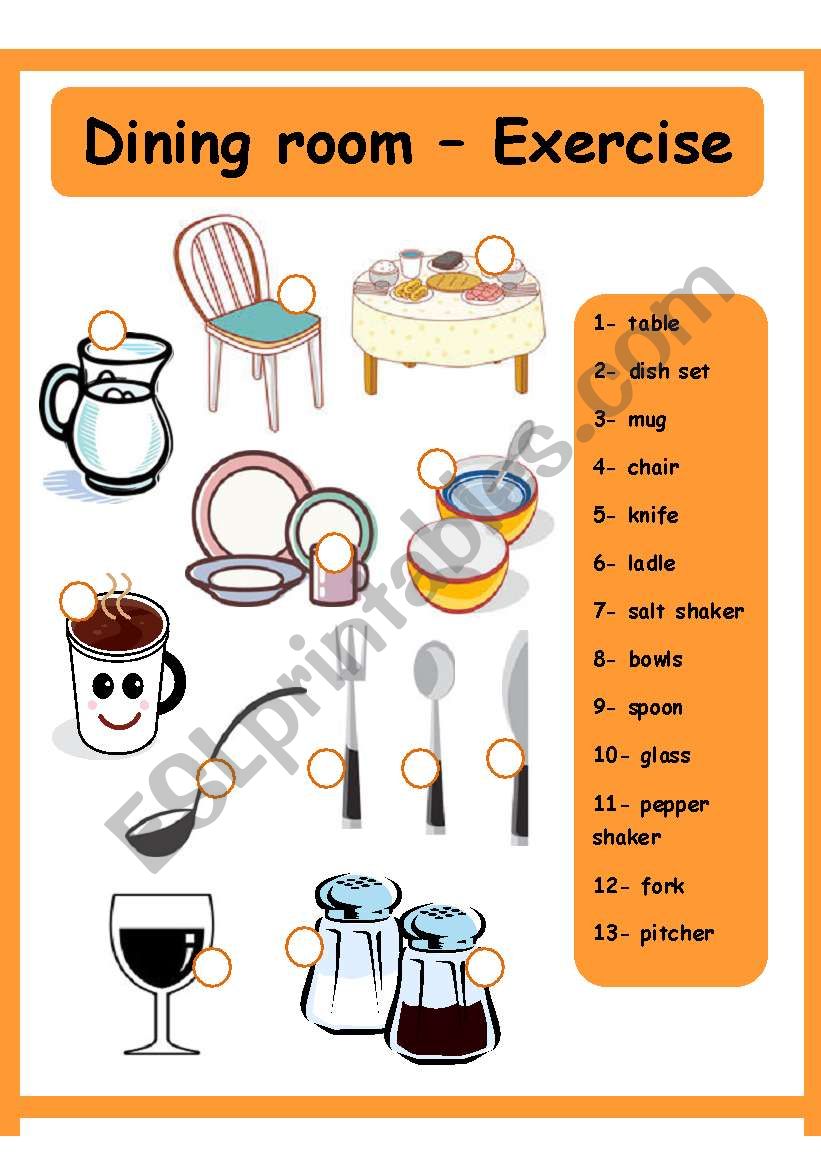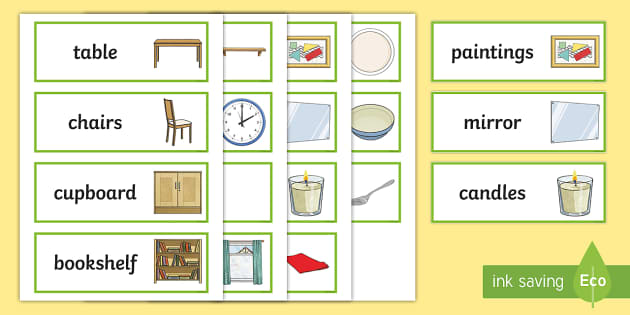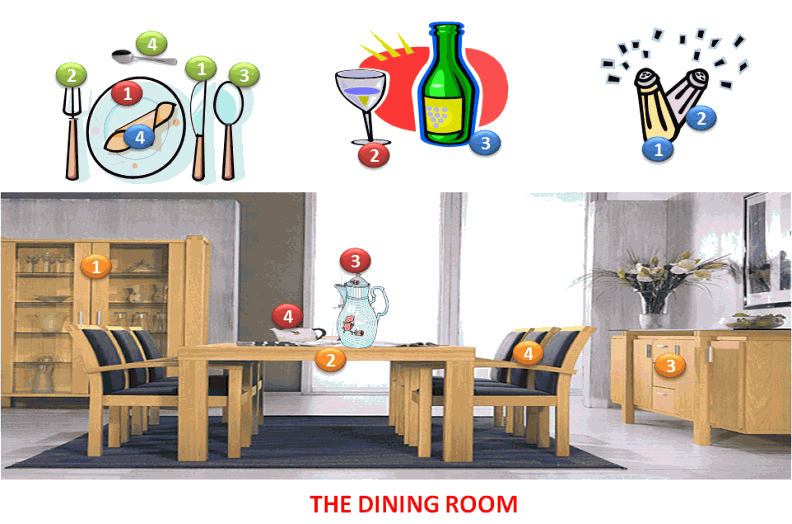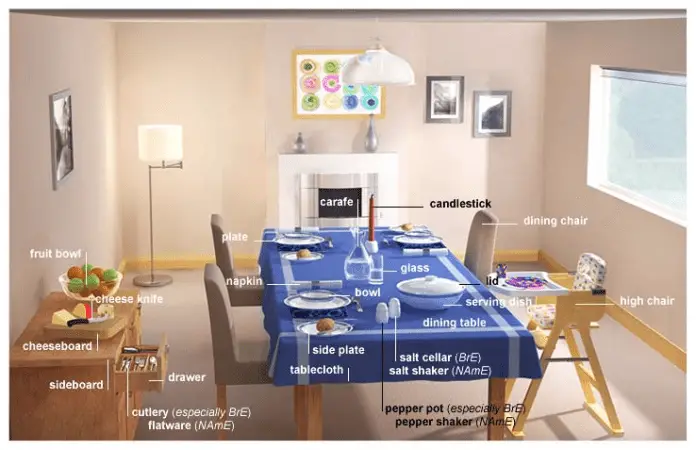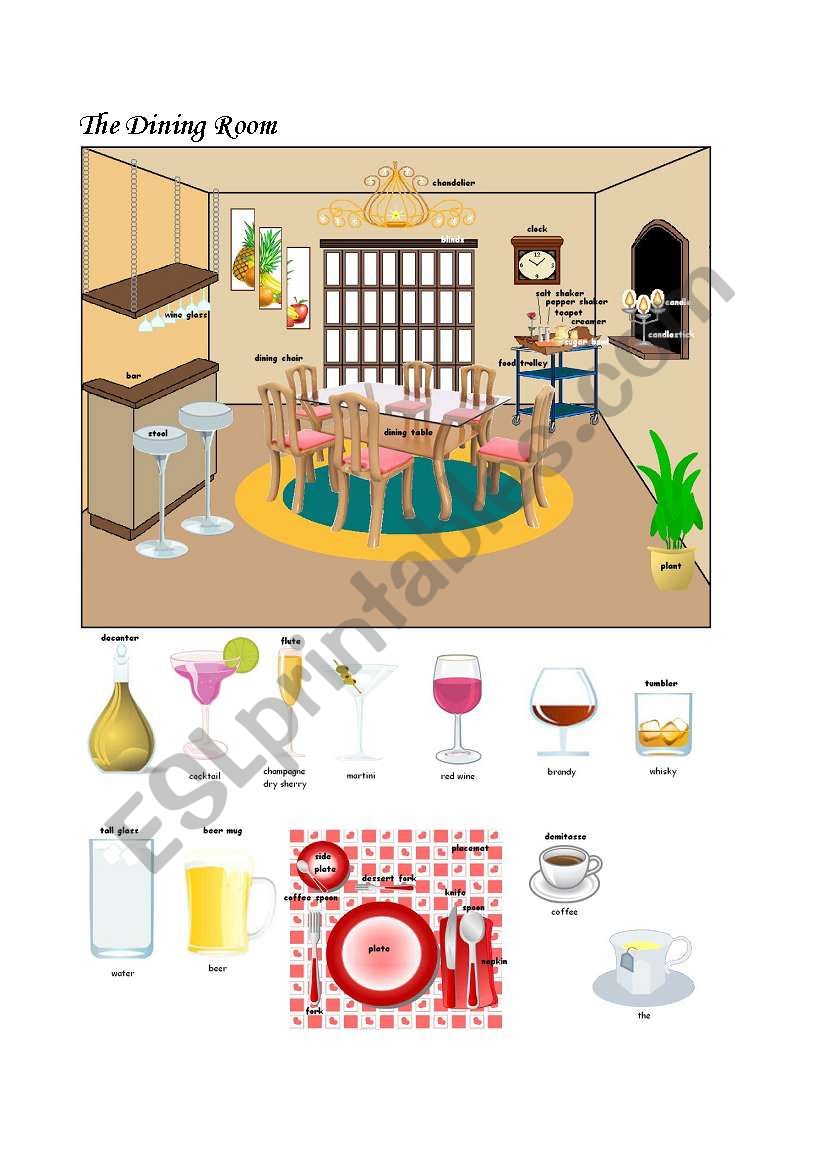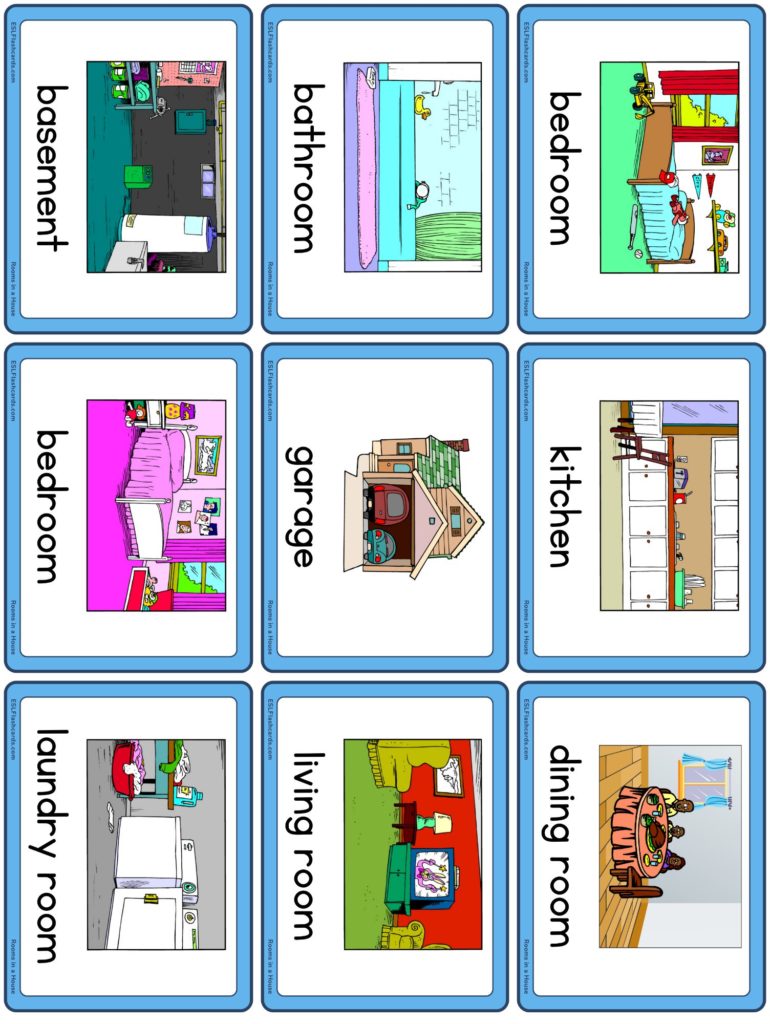Dining Room Vocabulary for ESL Students
As an ESL student, it's important to have a strong grasp of vocabulary related to the dining room. Whether you're learning English for academic, professional, or everyday purposes, knowing the words and phrases used in a dining room setting will help you navigate social situations and build your conversational skills. Here are the top 10 dining room vocabulary words and phrases for ESL students.
ESL Dining Room Vocabulary and Phrases
If you're an ESL student, you may already be familiar with some basic dining room vocabulary. But there are also specific phrases and expressions that are commonly used in a dining room setting. These phrases can help you communicate with wait staff, fellow diners, and hosts/hostesses. Here are some key phrases to add to your dining room vocabulary list:
Bill, please. This phrase is used to ask for the check or bill at the end of a meal. It's a polite and direct way to indicate that you're ready to pay.
Could we have a table for two? If you're making a reservation or asking for a table at a restaurant, this phrase is useful. It's important to specify the number of people in your party so the host/hostess can seat you appropriately.
Can I see the menu, please? This is a simple and polite way to ask for a menu. You can use this phrase when you're ready to order or just want to take a look at the options.
Is there a dress code? Some restaurants have dress codes, so it's important to ask about this before you go. This phrase is useful for finding out if there are any specific clothing requirements for the restaurant you're planning to visit.
Do you have any vegetarian options? If you have dietary restrictions, this phrase can come in handy. It's a polite way to ask if the restaurant has any dishes that are suitable for vegetarians.
Could we have separate checks? If you're eating with a group of friends or colleagues and want to split the bill, this phrase is useful. It's polite to ask for separate checks before you order, rather than after the bill has arrived.
Essential Dining Room Vocabulary for ESL Learners
There are certain words and phrases that are essential for any ESL learner to know when it comes to dining room vocabulary. These words are commonly used in a variety of dining settings and can help you build your conversational skills. Here are some essential dining room vocabulary words for ESL learners:
Table - This is the piece of furniture where you sit and eat your meal.
Napkin - A cloth or paper used to clean your hands or face while eating.
Plate - A dish used to serve food on.
Silverware/Cutlery - The utensils used to eat, such as a fork, knife, and spoon.
Glass - A drinking vessel made of glass.
Cup - A small container used for drinking hot beverages.
Menu - A list of food and drink options at a restaurant.
Order - The food and drink items you request from the menu.
Check/Bill - The slip of paper that lists the cost of your meal and drinks.
Tipping - Giving a gratuity to the wait staff for their service.
ESL Vocabulary for the Dining Room
Learning dining room vocabulary is not just about knowing the names of objects in the room. It's also important to know how to describe the actions and interactions that take place in a dining room. Here are some useful words and phrases to add to your vocabulary list:
Chew - To use your teeth to break down food into smaller pieces.
Swallow - To move food or drink from your mouth down into your stomach.
Sip - To take small drinks of a beverage.
Taste - To experience the flavor of food or drink by putting it in your mouth.
Smell - To sense the aroma of food or drink through your nose.
Order - To make a request for food or drink at a restaurant.
Serve - To bring food or drink to someone's table.
Clear - To remove used dishes and utensils from the table.
Pay - To give money in exchange for goods or services.
Thank you - A phrase used to express gratitude for someone's help or service.
Dining Room Vocabulary and Expressions for ESL Students
In addition to the words and phrases listed above, there are also some common expressions that are used in a dining room setting. These expressions can help you communicate with others and show your appreciation for a meal. Here are some useful dining room expressions for ESL students:
Bon appétit! - A French phrase used to wish someone an enjoyable meal.
Enjoy your meal! - A simple expression used to wish someone a good meal.
That was delicious! - An expression used to show appreciation for a tasty meal.
I'm stuffed! - An informal expression used to say you have eaten too much and are full.
Can I have a to-go box? - A phrase used to ask for a container to take unfinished food home with you.
I'll get the tip. - An expression used to offer to pay the gratuity for the meal.
I'll treat you! - An expression used to offer to pay for someone else's meal.
Common Dining Room Vocabulary for ESL Learners
There are certain words and phrases that are commonly used in a dining room setting, regardless of where you are in the world. These words and phrases are important for ESL learners to know, as they can help you communicate with others and understand dining customs in different cultures. Here are some common dining room vocabulary words for ESL learners:
Waiter/Waitress - The person who takes orders and serves food and drink at a restaurant.
Host/Hostess - The person who greets and seats guests at a restaurant.
Chef - The person who prepares food in a restaurant kitchen.
Tasting menu - A set menu with a series of small portions of food, usually served with wine pairings.
Chef's special - A dish recommended by the chef or made specifically for a particular day or occasion.
Reservation - A request to reserve a table at a restaurant for a specific date and time.
Buffet - A self-service dining option with a variety of food options.
Takeout - Food that is prepared and packaged to be eaten outside of the restaurant.
Drive-thru - A service at a restaurant where you can order and pick up food without leaving your car.
Tip - A gratuity given to the wait staff for their service.
ESL Dining Room Vocabulary and Conversation Practice
Now that you have a good understanding of dining room vocabulary, it's important to practice using these words and phrases in conversations. This will help you become more comfortable and fluent in using them. Here are some conversation practice ideas for ESL students:
Role play - Pair up with a classmate and practice ordering food and interacting with wait staff in a restaurant setting.
Watch videos - Find videos online that show conversations in a dining room setting and take note of the vocabulary used.
Join a conversation group - Join a conversation group or club where you can practice speaking English in a casual setting, such as over a meal.
Visit a restaurant - Go to a restaurant with friends and practice using dining room vocabulary in a real-life setting.
Play games - Play games with friends where you have to use dining room vocabulary, such as charades or Pictionary.
Dining Room Vocabulary and Activities for ESL Students
In addition to conversation practice, there are also other activities that can help you learn and reinforce dining room vocabulary. Here are some ideas for activities that ESL students can do to improve their dining room vocabulary:
Flashcards - Create flashcards with pictures and vocabulary words to help you memorize and recognize dining room items and phrases.
Matching game - Create a matching game with pictures and vocabulary words to help you practice associating the words with the items.
Word search - Create a word search puzzle with dining room vocabulary words for a fun and challenging way to reinforce your knowledge.
Scavenger hunt - Create a scavenger hunt activity where you have to find and identify different dining room items in a restaurant.
Fill in the blanks - Create a worksheet with sentences missing key dining room vocabulary words for you to fill in.
ESL Dining Room Vocabulary Flashcards and Games
One of the most effective ways to learn and memorize new vocabulary is through the use of flashcards and games. Here are some dining room vocabulary flashcards and games that you can use to practice and reinforce your knowledge:
Picture flashcards - These flashcards have a picture of a dining room item on one side and the vocabulary word on the other. Use them to test your recognition skills.
Matching game - Create a set of cards with pictures and vocabulary words and play a matching game with a friend or classmate.
Memory game - Create a set of cards with pictures and vocabulary words and play a memory game by trying to match the picture with the correct word.
Charades - Act out different dining room actions and have others guess the word or phrase you are portraying.
Pictionary - Draw pictures of different dining room items and have others guess the word or phrase you are drawing.
Dining Room Vocabulary and Worksheets for ESL Learners
In addition to flashcards and games, worksheets are another useful tool for learning and practicing dining room vocabulary. Here are some ideas for worksheets that ESL learners can use to improve their dining room vocabulary:
Fill in the blanks - Create a worksheet with sentences missing key dining room vocabulary words for students to fill in.
Word scramble - Create a worksheet with scrambled dining room vocabulary words for students to unscramble.
Word search - Create a word search puzzle with dining room vocabulary words for students to find and circle.
Crossword puzzle - Create a crossword puzzle with clues related to dining room vocabulary for students to fill in.
Labeling activity - Provide a picture of a dining room and have students label the different items using vocabulary words.
The Importance of a Well-Designed Dining Room in ESL Learning

Creating the Perfect Learning Environment
 When it comes to ESL learning, creating a conducive environment for students is crucial. A well-designed dining room can play a significant role in this. It is not just a space for meals, but it can also serve as a multi-functional area for learning and socializing. A visually appealing dining room can help create a positive and comfortable atmosphere for students to learn and thrive in.
When it comes to ESL learning, creating a conducive environment for students is crucial. A well-designed dining room can play a significant role in this. It is not just a space for meals, but it can also serve as a multi-functional area for learning and socializing. A visually appealing dining room can help create a positive and comfortable atmosphere for students to learn and thrive in.
Practical and Functional Design
 A dining room designed for ESL learning should be practical and functional. This means considering the needs of the students and the activities that will take place in the room.
Ample storage space
for learning materials and supplies is essential to keep the room organized and clutter-free.
Comfortable seating
is also crucial, as students will spend a considerable amount of time in the room. Tables and chairs should be
ergonomically designed
to promote good posture and prevent fatigue during long study sessions.
A dining room designed for ESL learning should be practical and functional. This means considering the needs of the students and the activities that will take place in the room.
Ample storage space
for learning materials and supplies is essential to keep the room organized and clutter-free.
Comfortable seating
is also crucial, as students will spend a considerable amount of time in the room. Tables and chairs should be
ergonomically designed
to promote good posture and prevent fatigue during long study sessions.
Stimulating Visuals
 A well-designed dining room should also have
stimulating visuals
that can aid in learning. Decorate the walls with posters, charts, and maps that can serve as learning aids. Incorporate colors and patterns that are
visually appealing
and can stimulate the mind. These visuals can also serve as conversation starters, promoting interaction and learning among students.
A well-designed dining room should also have
stimulating visuals
that can aid in learning. Decorate the walls with posters, charts, and maps that can serve as learning aids. Incorporate colors and patterns that are
visually appealing
and can stimulate the mind. These visuals can also serve as conversation starters, promoting interaction and learning among students.
Promoting Cultural Awareness
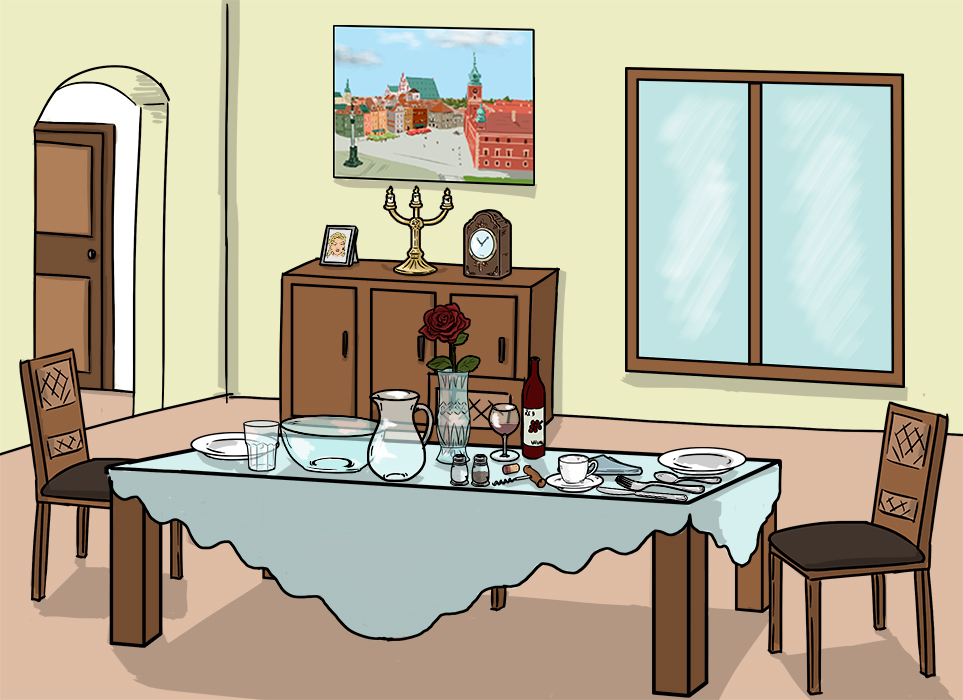 An ESL learning environment should also promote cultural awareness and diversity. The dining room can serve as a space to showcase different cultures through
decorations, food, and activities
. This can help students learn and appreciate different cultures, strengthening their understanding and respect for diversity.
An ESL learning environment should also promote cultural awareness and diversity. The dining room can serve as a space to showcase different cultures through
decorations, food, and activities
. This can help students learn and appreciate different cultures, strengthening their understanding and respect for diversity.
The Role of Vocabulary in ESL Learning
 In ESL learning, vocabulary is crucial for language acquisition. A well-designed dining room can help
enhance vocabulary learning
. By incorporating labels, menus, and other print materials in the room, students can learn new words in a natural and practical way. This can also help reinforce their vocabulary retention and usage.
In ESL learning, vocabulary is crucial for language acquisition. A well-designed dining room can help
enhance vocabulary learning
. By incorporating labels, menus, and other print materials in the room, students can learn new words in a natural and practical way. This can also help reinforce their vocabulary retention and usage.
In Conclusion
 A well-designed dining room can have a significant impact on ESL learning. It can create a positive and comfortable environment for students to learn and thrive in. By considering practicality, functionality, visuals, and cultural awareness, the dining room can become a valuable tool in language acquisition. So, when designing a dining room for ESL learning, remember to keep in mind the needs of the students and create a space that is both functional and visually appealing.
A well-designed dining room can have a significant impact on ESL learning. It can create a positive and comfortable environment for students to learn and thrive in. By considering practicality, functionality, visuals, and cultural awareness, the dining room can become a valuable tool in language acquisition. So, when designing a dining room for ESL learning, remember to keep in mind the needs of the students and create a space that is both functional and visually appealing.












